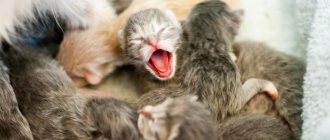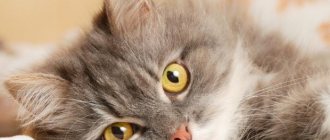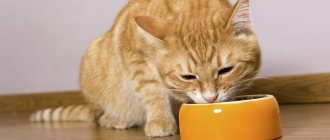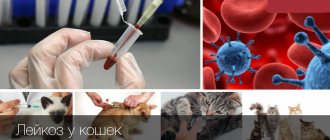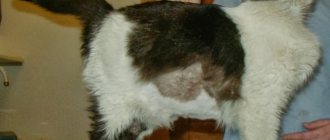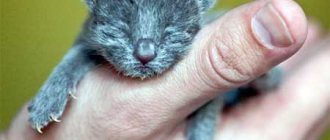What it is?
This is the name of a pathology in which the volume of the lungs increases noticeably due to the expansion of the alveoli (alveolar) or interstitial tissue (interstitial). What does this mean? The cat cannot inhale and exhale normally and has problems getting enough oxygen into the blood. Chronic hypoxia develops, fraught with the appearance of a whole bunch of functional disorders in the body, since not only the brain, but also the liver and kidneys will suffer from lack of air.
It is assumed that the nature of the disease is inflammatory. It is irreversible and tends to constantly develop. Very often, emphysema is mistaken for chronic bronchitis, since the external manifestations of these diseases are very similar.
Etiology and predisposing factors
The exact causes of this disease in cats are not fully understood. But it is known for sure that emphysema in many cases develops in those cats that have inhaled tobacco smoke for a long time, been exposed to allergens, and suffered from chronic diseases of the upper respiratory tract and, oddly enough, the oral cavity.
Are there predisposing factors that worsen the course of the disease? Yes. Obesity in this regard is very dangerous. No less unpleasant is any inflammatory infection of the oral cavity, since bacteria from foci of suppuration easily enter the upper respiratory tract, greatly accelerating and worsening the course of the disease.
Development of the disease and clinical picture
In its early stages, an inflammatory reaction develops in the small bronchioles and alveoli. Constant and not going away, it causes the appearance of scar tissue, and coughing, which at that time is the only symptom, contributes to their expansion. The alveoli and bronchi can no longer return to their normal state. The good news is that the disease develops slowly and can be slowed down.
Is there information about the most predisposed animals and specific breeds? The disease most often affects old cats (more precisely, it begins to manifest itself) and middle-aged cats (for the same reasons). Some veterinarians suggest that Siamese cats are initially predisposed to emphysema.
As we said, in the early stages the presence of the disease can be judged by a constant, painful cough. It is very dry and hard, after which the animal may even vomit. But often you won’t see these signs either. One can only notice that the animal seems to have “less energy” and tries to avoid active games. Old cats sometimes begin to “snore” when inhaling, exhaling air heavily and with a hiss. In later stages, the gums may take on a bluish tint as a result of lack of oxygen. In general, emphysema in a cat is certainly not a fatal disease; the animal’s condition remains within normal limits for a long time.
About methods of treatment and prevention
As we said, there is no specific treatment. Therapy is symptomatic. Only in particularly advanced cases, when the cat begins to clearly choke, is hospitalization, intravenous infusions of antispasmodics and antihistamines, and the prescription of anti-inflammatory drugs possible. They allow you to stop an attack.
Bronchodilators are widely used, which help to partially restore the elasticity of the alveoli and bronchi, which are not yet severely affected by the disease, and also contribute to the evacuation of accumulated exudate from them. This improves overall ventilation of the lungs and helps fight hypoxia. Antitussive medications, antibiotics if there is a possibility of a secondary bacterial infection, and/or corticosteroids are prescribed to combat inflammation and the same cough. Isolating the cat from allergens helps to cope with relapses of the disease.
If an animal is overweight, a diet is recommended. The veterinarian may also recommend some immunomodulators or other means that improve the general condition of the body. Finally, we strongly recommend that you take care of your pet's oral health. If there are signs of tartar, gingivitis, periodontal disease or other diseases, they are treated immediately. When the constant source of infection is removed, the chances of relapse drop sharply.
Subcutaneous type of emphysema
But emphysema is not just a lung disease. There is also subcutaneous emphysema: this pathology is rare in cats (as well as other animals), but there are many problems from it.
From the name of the disease it is clear that in this case some volumes of air end up under the skin. Of course, the reasons for this are exclusively pathological: severe injuries, puncture wounds. Of course, this disease in itself is not fatal, but along with the air, a lot of pathogenic and conditionally pathogenic microflora enter the subcutaneous tissue. However, the treatment is quite simple: the trapped gases are removed using a needle or incisions in the skin, and the animal can be prescribed antibiotics to avoid the development of secondary infections. Wounds are treated in a general manner.
Treatment of emphysema in cats
First, you need to provide the sick cat with proper care:
- exclude physical activity;
- maintain a hygienic regime;
- adjust your diet;
- fortify the diet.
Next you should move on to drug treatment. Veterinarians usually recommend subcutaneous injections of ephedrine and atropine. Eufillin is prescribed internally. To stimulate cardiac activity, drugs based on camphor oil, glucose and digitalis are prescribed. The following are prescribed as antiallergic drugs: aminazine, calcium chloride, propazine, suprastin, aminazine.
For complicated forms, treatment similar to that used to combat pneumonia and bronchitis is used.
Why do cats purr and what does it mean?
Cats have conquered the whole world. And the gentle purring definitely helped them with this! Did you know that purring is not only pleasant music for our ears, but also has health benefits?
Numerous studies by American scientists (*researchers Robert Eklund, Gustav Peters, Elizabeth Duthie from the University of London, animal communication specialist Elizabeth von Muggenthaler from North Carolina and others) have shown that the purring sounds and vibrations of a cat’s body have a positive effect on human health. They calm you down, even out your breathing and heart rate, eliminate stress and insomnia, and even strengthen your bones! It's no surprise that cats are the stars of pet therapy.
How do cats purr?
Have you ever wondered where the organ responsible for purring is located in a cat? What processes take place in the body for us to hear the cherished “purrr”? How do cats do it anyway?
The purring process originates in the brain: electrical impulses arise in the cerebral cortex. They are then “thrown” onto the vocal cords and cause them to contract. The vocal cords move, alternately narrowing and widening the glottis. And then the fun part. The cat has a special purring organ - the hyoid bones. When the vocal cords contract, these bones begin to vibrate - and that’s when you and I hear the treasured “urrrrr”. Usually the “purr” occurs when the cat exhales, and its body pleasantly vibrates to the beat.
Do all cats purr?
Do you think only domestic cats can purr? In fact, this is the talent of many representatives of the cat family, and with them some viverrids.
Yes, yes, wild cats purr in their natural habitat, just like your Scottish Fold. But the frequency, duration and amplitude of their purring are noticeably different. Thus, the frequency of a cheetah's purr is approximately 20-140 Hz, and a domestic cat falls within the range from 25 to 50 (*according to Elisabeth von Muggenthaler, a specialist in the field of bioacoustics from the Institute for Fauna Communication in North Carolina.).
Talented “purrs” in the wild are, for example, lynxes and forest cats, and among civets, common and tiger genets (civets). They would definitely give your purr a run for their money!
What does it mean when a cat purrs?
It is generally accepted that a cat purrs when she feels good. So she feasted on her favorite sausage with tuna and settled down on the warm lap of the hostess - how can she stay here?
Indeed, a pet purrs when it is fed, warm and calm. He may reward you with a gentle purr when you talk to him affectionately. When you scratch his ear. When you go to the refrigerator to get canned goods. When giving a super soft fleecy bed. In a word, when you create comfortable, safe conditions and show your love. But these are not all the reasons.
It turns out that a cat can purr not only when she feels good, but also when she feels very bad.
Many cats begin to purr during childbirth or when they are sick. Others purr when they are stressed, afraid or angry. For example, a cat may suddenly purr while sitting in a carrier on a rumbling bus. She probably doesn't like this journey. Most likely she is afraid.
There is a theory that purring promotes the production of a hormone that reduces pain and calms the cat. That is, if a cat feels bad, it begins to purr to heal or calm itself. Researchers at the University of California believe that purring (or rather, body vibration) also tones the musculoskeletal system. After all, cats are avid sleepers; they spend a lot of time without moving. It turns out that purring is also a kind of passive fitness.
Purring is also a way of communication. By purring, cats communicate with humans and with each other. The nursing mother begins to purr so that the kittens will react and crawl up to drink milk. During feeding, she continues to purr to calm her babies. Kittens purr to tell their mother: “We’re full.” Adult cats purr to invite their fellow cats to play. But the most amazing thing is that a healthy cat can start purring when it sees another cat that is in pain. Empathy is not alien to them.
Researchers have not yet established all the reasons why cats purr. However, it is known that each pet has several variants of purring, and each of these variants has its own purpose. The cat knows exactly how to purr so that you give her a treat. And she purrs completely differently when she’s just bored or when she’s interacting with another cat. These are such charming animals with their own “superpowers”.
Why does a cat purr and stomp its paws?
Cat owners often ask why a cat purrs and tramples something with its paws at the same time. For example, a pillow, a blanket or the owner’s lap? The answer is pleasant: at these moments your cat feels very good.
For cats, this behavior is a throwback to deep childhood. When kittens drink mom's milk, they purr and massage mom's belly with their paws ("milk step") to increase milk flow. For many, this scenario is not forgotten even in adulthood. Of course, the cat no longer asks for milk. But when she feels good, nourished, warm and safe, the child’s pattern of behavior makes itself felt.
If your cat often purrs and paws at you, congratulations: you are a great owner!
What to do if your cat stops purring?
And this also happens. The owners say that their cat does not know how to purr at all, or that at first she purred and then stopped.
The first one is simple. Do you remember that each cat has its own purr? Some pets rumble like tractors throughout the house, while others do it silently. Sometimes you can understand that a cat is purring only by a slight vibration of the chest or abdomen - you can feel it by placing your palm on the cat. It turns out that you don’t hear “purr”, but the cat actually purrs.
Each cat has its own purr, it is an individual innate feature. Some purr loudly, others almost inaudibly. This is fine.
It’s another matter if at first the cat purred, and then suddenly stopped and hasn’t purred at all for a long time. Most likely it's stress. Perhaps the cat no longer feels safe. She may have lost trust in you or is jealous of your other pet or child. Sometimes this behavior can become a symptom of illness.
Your correct action in this case is to contact a veterinarian to rule out health problems, and consult with a zoopsychologist. An animal psychologist can point out points of content that you had not thought about before, but which turned out to be important, and will help you establish an “owner-pet” connection.
How to help a cat purr?
If your cat is healthy and feeling well, you can “help” her purr by introducing new toys and treats into your interaction. These are reliable tools both in establishing contact and relieving stress, and in education. Play with your cat more often in a calm atmosphere, demonstrate your involvement, your attention, and for success (or just because) treat him with healthy treats from the palm of your hand.
Don't expect a quick response. Your task is not to achieve purring immediately after you have played teasing with your cat and treated it to sausage. No. You must show her that you are a team. That you can be trusted. That you love her and care about her. That she's safe at home.
And then, one fine day (most likely suddenly and unexpectedly) your cat will jump onto your lap, curl up in a ball and rain down on you the most melodic and velvety “purr” that she is only capable of. Enjoy, you deserve it!




